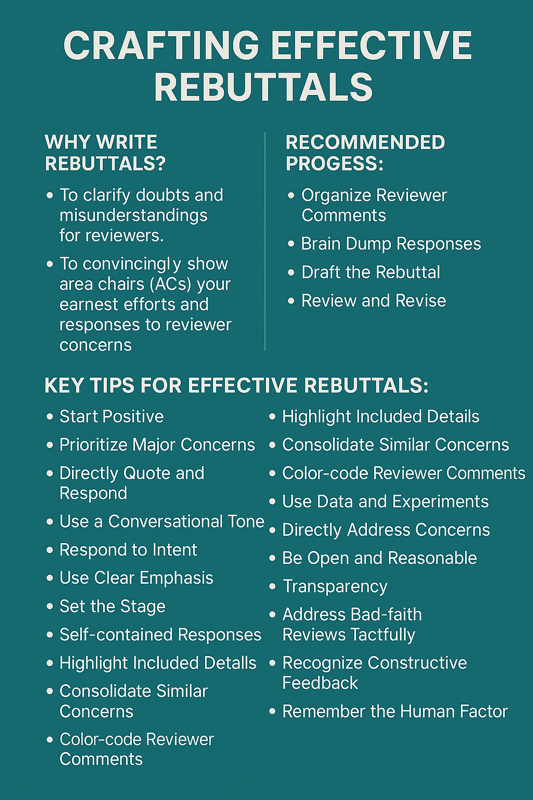🎯 Crafting Effective Rebuttals for Top AI Conference Submissions
Peer Review in Computer Science: good, bad & broken
1
Posts
1
Posters
150
Views
-

Crafting effective rebuttals is a critical skill for researchers aiming to publish in prestigious conferences. Devi Parikh, Dhruv Batra, and Stefan Lee provide valuable insights on writing rebuttals from experience with AI conferences (e.g., CVPR, ECCV, ICCV, NeurIPS, ICLR, EMNLP), helping you clearly communicate your ideas and convincingly address reviewer feedback. Here’s a structured approach based on their guide:Why Write Rebuttals?
- Clarify doubts and misunderstandings for reviewers.
- Convince area chairs (ACs) of your earnest efforts and responses to reviewer concerns.
Recommended Process:
- Organize Reviewer Comments: Use a spreadsheet early to track common concerns and necessary responses (handy spreadsheet here).
- Brain Dump Responses: Initially, note down rough responses without focusing on length or style.
- Draft the Rebuttal: Transform these responses into concise, structured rebuttal text.
- Review and Revise: Ensure you've comprehensively addressed all concerns, prioritize effectively, and meet space constraints.
Key Tips for Effective Rebuttals:
 Start Positive: Highlight positive feedback from reviewers.
Start Positive: Highlight positive feedback from reviewers. Prioritize Major Concerns: Address significant issues first.
Prioritize Major Concerns: Address significant issues first. Directly Quote and Respond: Clearly restate and directly address reviewer concerns.
Directly Quote and Respond: Clearly restate and directly address reviewer concerns. Use a Conversational Tone: Make responses friendly and clear rather than combative.
Use a Conversational Tone: Make responses friendly and clear rather than combative. Respond to Intent: Tackle the underlying issues behind reviewers’ questions.
Respond to Intent: Tackle the underlying issues behind reviewers’ questions. Use Clear Emphasis: Be assertive on critical points.
Use Clear Emphasis: Be assertive on critical points. Set the Stage: Briefly summarize core ideas if reviewers missed key points.
Set the Stage: Briefly summarize core ideas if reviewers missed key points. Self-contained Responses: Provide necessary context and details within the rebuttal itself.
Self-contained Responses: Provide necessary context and details within the rebuttal itself. Highlight Included Details: Clearly reference details already present in your paper.
Highlight Included Details: Clearly reference details already present in your paper. Consolidate Similar Concerns: Address common issues collectively.
Consolidate Similar Concerns: Address common issues collectively. Color-code Reviewer Comments: Visually distinguish reviewer feedback.
Color-code Reviewer Comments: Visually distinguish reviewer feedback. Use Data and Experiments: Support claims with solid data or additional experiments.
Use Data and Experiments: Support claims with solid data or additional experiments. Directly Address Concerns: Demonstrate immediate changes rather than promising future revisions.
Directly Address Concerns: Demonstrate immediate changes rather than promising future revisions. Be Open and Reasonable: Actively consider and test reviewer suggestions.
Be Open and Reasonable: Actively consider and test reviewer suggestions. Transparency: Be upfront about any practical constraints.
Transparency: Be upfront about any practical constraints. Address Bad-faith Reviews Tactfully: Politely and clearly handle unfair critiques.
Address Bad-faith Reviews Tactfully: Politely and clearly handle unfair critiques. Recognize Constructive Feedback: Thank reviewers providing valuable feedback.
Recognize Constructive Feedback: Thank reviewers providing valuable feedback. Remember the Human Factor: Engage empathetically and maintain goodwill.
Remember the Human Factor: Engage empathetically and maintain goodwill.
Following these structured steps and practical tips can significantly enhance the clarity, effectiveness, and success of your rebuttals in top-tier conference submissions.
